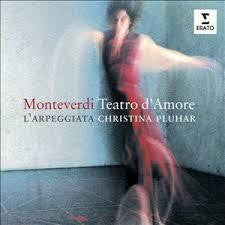BAROQUE - Early opera and instrumental music
BAROQUE - Early opera and instrumental music
This week we were focussed on two greats of the Baroque era: MONTEVERDI and J.S. BACH... here are a couple of youtube performances of the pieces we covered...
CLAUDIO MONTEVERDI: L'Orfeo (1607)
The drama: In a prologue the figure of Music introduces the piece, a demonstration of the power of music. Orpheus and Eurydice are at last to marry, an event celebrated in dance and song by the shepherd company. The second act continues the celebration of the happiness of Orpheus, interrupted by the appearance of the messenger Sylvia, who breaks the news of the death of Eurydice, before leaving to shun human company, marked by the bad news she has brought. Orpheus, accompanied by Hope, sets out for the Underworld. She leaves him as he approaches the Styx, eventually overpowering the boatman of the dead, Charon, with his music, and crossing the river. In the kingdom of Pluto, Proserpina pleads with her husband for the release of Eurydice, and she is allowed to leave, following Orpheus, provided that he does not look round. As he walks away, doubts assail him and he looks round, only to lose Eurydice, who must now remain in the Underworld. The act finds Orpheus alone in the fields of Thrace, comforted by Echo. In the published libretto and, presumably, in the first performance in the palace of the Duke of Mantua, Orpheus is then set upon by Bacchantes, who tear him in pieces. In Monteverdi's score this is replaced by a final apotheosis, when Apollo appears as a deus ex machina, descending on a cloud machine to raise Orpheus to the stars, whence he can eternally gaze on the image of Eurydice in the sun and stars.
(Naxos.com - education synopsis)
In this early opera we can see emotion injected into the musical drama, tonality (major and minor keys) are used to portray different emotional contexts, and this is particularly noticeable as the messenger Sylvia makes her entrance (approx. 31:33) the major key monody sung by the shepherd changes to a minor key recitative (speech-like song) sung by Sylvia. There is also a shift in instrumental accompaniment that further underpins and highlights the emotional drama: the shepherd's song is accompanied by harpsichord, while Sylvia's recitative is accompanied by theorbo and organ. The tempo of her recitative is noticeably slower and this music clearly communicates grief for Eurydice and the gravity of her message. Note the constant shift in tone from the messenger back to the shepherds in the following few minutes. The shift back to a major key in the shepherd's monody portrays musically that the shepherds do not quite understand, the initial shock of grave news is almost unbelievable, and takes some time to sink in.
Here is the entire youtube clip for Act II of L'Orfeo:
https://www.youtube.com/watch?v=0mD16EVxNOM
Enjoy this piece and see what other interesting things you can pick up yourself!
JOHANN SEBASTIAN BACH: Brandenburg Concerto No. 5 (probably written in 1719)
Wow I love this piece, no matter how many times I hear it. This instrumental music comes under the genre concerto grosso. A concerto grosso has a group of soloists rather than just one soloist. This soloist group known as a concertino, alternates performing music with the whole orchestra - ripieno. The concertino in the Brandenburg concerto is made up of a flute, violin and (very unsusually!!!!) a harpsichord. The form of this piece is ritornello form. In essence a ritornello is a returning instrumental passage (played by the orchestra) that alternates with episodes - played by the soloist group. The following diagram expresses the structure of ritornello form:
R --- E --- R --- E --- R --- E --- R --- E etc...
When listening, see if you can hear the similarities in the ritornello passages though they may be performed in keys other than the original key of the first ritornello passage)....
https://www.youtube.com/watch?v=BnjqGhAlFzs
Also as you listen note how the harpsichord begins playing a basso continuo accompaniment that gradually becomes more and more complex until (at around 6:30) the harpsichord is the only solo performer and this harpsichord cadenza (written out or improvised ornamental passage - in this case written out but may be mistaken for improvised) lasts for many minutes. So, not only is it unusual for harpsichord to be used as a solo instrument at this time, but the way in which the harpsichord is used in this work is outside of the normal basso continuo role expected for harpsichord. I could write a whole lot more about this and other pieces we have looked at, however as usual the music speaks for itself!
Enjoy these or if you are still hanging out for some more, we also looked at the following pieces, find them on youtube:
ARCHANGELO CORELLI, Trio Sonata Op. 3, No. 2
GUILO CACCINI, Vedro 'l mio sol
LOVE BAROQUE MUSIC???
Check out this stock we currently have in store:


J.S. Bach: Brandenburg Concertos
More J.S. BACH products instore
Or let us know if you are looking for a specific piece by any of these composers and we can order it in for you!
Happy listening!








